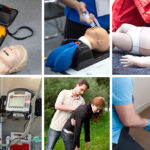The idea of whether or not CPR should be taught in schools is one that is open to debate in a lot of people’s eyes. Some will argue that schools simply don’t have the funding available to offer such a course to their students. Others will say that the time commitment associated with training is simply too significant to justify adding it to the curriculum.
On the other hand, proponents of offering CPR courses in schools, namely high schools, argue that CPR is an essential skill set that everyone should be learning. The idea is that CPR can be taught during another class, such as health or perhaps even physical education. The program would be incorporated into such a class, and when completed, students will receive their CPR certification. People who argue in favor of teaching CPR in schools say that proper CPR training should be put at the forefront of health education. Their view is that, regardless of budget or other concerns, there is nothing more important than learning the skills necessary to save a life.
Regardless of where you fall in the debate, it’s important to acknowledge the importance of proper CPR training and look into the ways in which it can be helpful to educate all high school students in CPR procedures. American CPR Care Association advocates that every American should possess the necessary skills to perform CPR safely and effectively. We offer online CPR/AED certification and recertification courses specifically because we believe in the importance of these lifesaving skills.
However, despite the necessity and importance of proper CPR training, it may be difficult to see why CPR should be a required skill set that all high school students must learn. In this blog, we will explore that concept and answer the question of whether or not CPR should truly be taught in schools.
The Potential Drawbacks of Teaching CPR in Schools
First, it’s important to note that there are some very valid concerns when it comes to introducing mandatory CPR training in high schools. Some of the most common complaints associated with this idea are:
It’s an Added Expense:
Let’s face it: Despite the fact that most everyone wants America’s high schools to flourish with an abundance of funding, that’s simply not the reality. Many high schools struggle with offering even basic courses, including physical education classes and music instruction. Thus, it’s important to understand that some schools are going to have a very difficult time finding the extra funds needed to keep a CPR course afloat. There are many costs associated with offering an additional course, such as supplies and the faculty members required to teach it.
It Takes Up Time:
In addition, many schools already offer so many different essential classes that it’s hard to justify putting another one on the curriculum. Students are often already overwhelmed by the number of required classes they must take, especially as upperclassmen. In addition, they often have other academic commitments, such as band or orchestra, taking AP classes, utilizing vocational programs, and so on. Thus, finding the time within their schedules to take a mandated CPR course can be very challenging.
It Can Be a Challenge to Find a Qualified Instructor:
Remember that someone who is qualified to teach CPR must have credentials in a number of areas. They must be qualified to teach at the high school level, and they must also have their CPR certification and have a certain level of experience in order to be a qualified CPR instructor. In addition, most states require high school teachers to have a certain level of higher education, often a master’s degree, and they must also be up to date with all other state requirements and teaching certifications.
The Benefits of Teaching CPR in Schools
Despite the fact that there are several reasons why teaching CPR in schools can be a challenge, there are a plethora of benefits to teaching this essential skill in high school. Some of the most pronounced benefits are:
CPR Training Teaches Students How to Save a Life:
One of the most obvious and significant benefits of teaching CPR in schools is that it increases the number of people in the world who are qualified to deal with someone who is suffering from cardiac arrest. Sudden cardiac arrest is actually the leading cause of death in both the United States and Canada. Therefore, increasing the number of people who are capable of administering CPR to someone experiencing cardiac arrest is beneficial for all of society.
CPR Courses Can Prepare Students for Some Professions and College Programs:
Additionally, there are many professions that require people to have up-to-date CPR certifications. Specifically, first-responders are almost always required to have CPR certifications, and some of those professions can be entered into right after high school. As CPR certification is generally valid for two years, students may find themselves much more prepared to begin training in certain areas immediately after highschool. Moreover, for students entering college with an emphasis on medical training, having previous experience in a CPR course can be essential preparation. It will give them a taste of the requirements that they’ll need to fulfill throughout their college experience and future career.
CPR Courses Can Teach Students to Care for Themselves:
Because cardiac arrest is such a common occurrence in the United States, it’s important for everyone to be aware of the different factors that can lead to heart failure. In a CPR course, students may learn about the different reasons that people suffer from cardiac failure and may feel encouraged to adjust their habits as a result. This can mean perhaps modifying their diet or getting more exercise.
In addition, a CPR course can help show that oftentimes risky behaviors, such as consuming an excessive amount of alcohol, can lead to cardiac arrest. Because high school students often deal with temptations such as alcohol, learning about the ways in which it can harm them can lead to them engaging in safer behavior.
Conclusion
Even though there are some concerns associated with mandating CPR courses in high schools, there are clearly some significant benefits to doing so. Luckily, CPR certification can be completed quickly and easily, especially with the use of online certification programs. American CPR Care Association focuses on individual and group programs, so reach out to us today in order to see your options for becoming CPR/AED certified. Visit our website or contact us at [email protected] or 1-888-808-9109.







